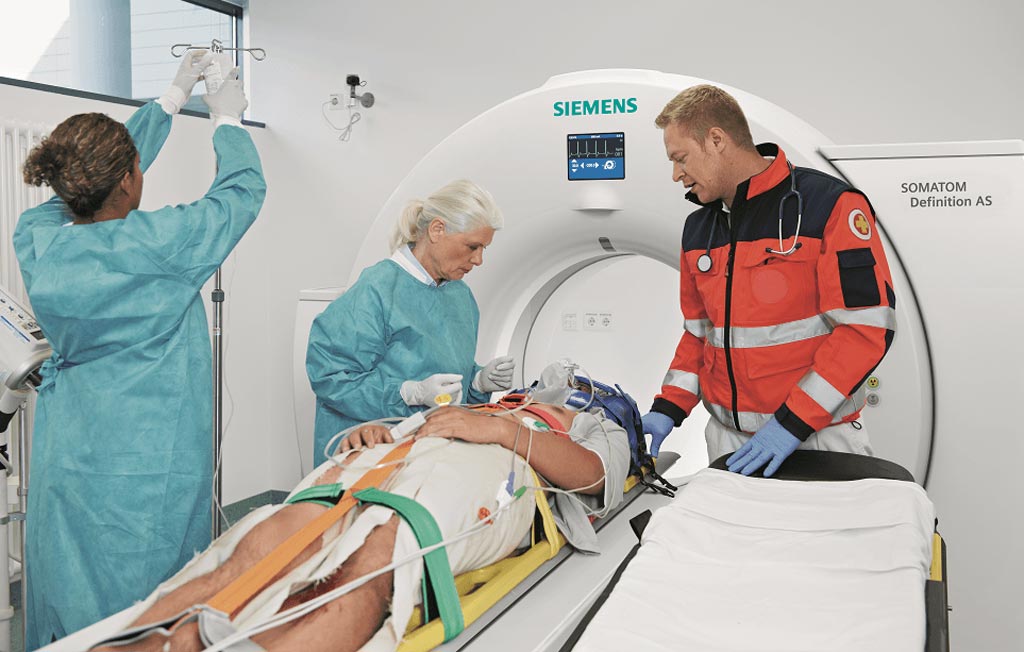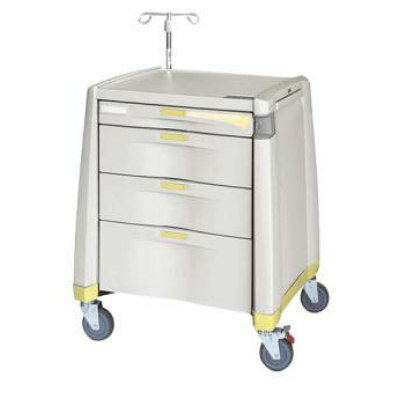EHR Decision Support Reduces Emergency Imaging
|
By HospiMedica International staff writers Posted on 01 Aug 2017 |

Image: A new study shows decision support software can help ED clinicians determine the need for a CT (Photo courtesy of Siemens Healthcare).
A new study shows that embedding clinical decision support (CDS) software in the electronic health record (EHR) can decrease the use of high-cost imaging in the emergency department (ED).
Researchers at the University of Colorado School of Medicine (Aurora, CO, USA), Poudre Valley Hospital (Fort Collins, CO, USA), and other institutions conducted a longitudinal study in five EDs in a single healthcare system with a common EHR. During the study, validated scoring tools for identifying head injury, C-spine injury, and pulmonary embolism (PE) were embedded into the EHR. The main outcome was the proportion of computerized tomography (CT) scans ordered by provider.
The results revealed that out of 235,858 total patient visits in all study sites there was greater than 6% decrease in utilization of CT brain and CT C-spine; the use of CT for PE was also decreased, but was not significant. For all CT types, high utilizers in the pre-intervention period decreased usage over 14% in the post-intervention period with CT brain, CT C-spine, and CT PE, without changing their usage practices. For CT brain, low utilizers did not increase usage, but for CT C-spine and CT PE usage was increased. The study was published on July 11, 2017, in Academic Emergency Medicine.
“Integrating CDS into the provider workflow promotes usage of validated tools across providers, which can standardize the delivery of care and improve compliance with evidence-based guidelines,” said lead author Kelly Bookman, MD, director of the emergency medicine department at Poudre Valley Hospital. “Getting CDS delivered at the right time, to the right person, seamlessly within their workflow is the key to driving compliance with standardized, evidence based, best practices.”
CDS involves a variety of tools to enhance decision-making in the clinical workflow, including current guidelines, computerized alerts and reminders to care providers and patients, condition-specific order sets, focused patient data reports and summaries, documentation templates, diagnostic support, and contextually relevant reference information, among others. CDS requires computable biomedical knowledge, person-specific data, and a reasoning or inferencing mechanism that combines knowledge and data to generate and present helpful information to clinicians as care is being delivered.
Related Links:
University of Colorado School of Medicine
Poudre Valley Hospital
Researchers at the University of Colorado School of Medicine (Aurora, CO, USA), Poudre Valley Hospital (Fort Collins, CO, USA), and other institutions conducted a longitudinal study in five EDs in a single healthcare system with a common EHR. During the study, validated scoring tools for identifying head injury, C-spine injury, and pulmonary embolism (PE) were embedded into the EHR. The main outcome was the proportion of computerized tomography (CT) scans ordered by provider.
The results revealed that out of 235,858 total patient visits in all study sites there was greater than 6% decrease in utilization of CT brain and CT C-spine; the use of CT for PE was also decreased, but was not significant. For all CT types, high utilizers in the pre-intervention period decreased usage over 14% in the post-intervention period with CT brain, CT C-spine, and CT PE, without changing their usage practices. For CT brain, low utilizers did not increase usage, but for CT C-spine and CT PE usage was increased. The study was published on July 11, 2017, in Academic Emergency Medicine.
“Integrating CDS into the provider workflow promotes usage of validated tools across providers, which can standardize the delivery of care and improve compliance with evidence-based guidelines,” said lead author Kelly Bookman, MD, director of the emergency medicine department at Poudre Valley Hospital. “Getting CDS delivered at the right time, to the right person, seamlessly within their workflow is the key to driving compliance with standardized, evidence based, best practices.”
CDS involves a variety of tools to enhance decision-making in the clinical workflow, including current guidelines, computerized alerts and reminders to care providers and patients, condition-specific order sets, focused patient data reports and summaries, documentation templates, diagnostic support, and contextually relevant reference information, among others. CDS requires computable biomedical knowledge, person-specific data, and a reasoning or inferencing mechanism that combines knowledge and data to generate and present helpful information to clinicians as care is being delivered.
Related Links:
University of Colorado School of Medicine
Poudre Valley Hospital
Latest Critical Care News
- 'Universal' Kidney to Match Any Blood Type
- Light-Based Technology to Measure Brain Blood Flow Could Diagnose Stroke and TBI
- AI Heart Attack Risk Assessment Tool Outperforms Existing Methods
- Smartphone Imaging System Enables Early Oral Cancer Detection
- Swallowable Pill-Sized Bioprinter Treats GI Tract Injuries

- Personalized Brain “Pacemakers” Could Help Patients with Hard-To-Treat Epilepsy
- Microscopic DNA Flower Robots to Enable Precision Medicine Delivery
- Origami Robots to Deliver Medicine Less Invasively and More Effectively
- Improved Cough-Detection Technology Aids Health Monitoring
- AI Identifies Children in ER Likely to Develop Sepsis Within 48 Hours
- New Radiofrequency Therapy Slows Glioblastoma Growth
- Battery-Free Wireless Multi-Sensing Platform Revolutionizes Pressure Injury Detection
- Multimodal AI to Revolutionize Cardiovascular Disease Diagnosis and Treatment
- AI System Reveals Hidden Diagnostic Patterns in Electronic Health Records
- Highly Sensitive On-Skin Sensing Monitor Detects Vitamin B6 and Glucose in Sweat
- Artificial Intelligence Revolutionizing Pediatric Anesthesia Management
Channels
Surgical Techniques
view channel
Minimally Invasive Endoscopic Surgery Improves Severe Stroke Outcomes
Intracerebral hemorrhage, a type of stroke caused by bleeding deep within the brain, remains one of the most challenging neurological emergencies to treat. Accounting for about 15% of all strokes, it carries... Read more
Novel Glue Prevents Complications After Breast Cancer Surgery
Seroma and prolonged lymphorrhea are among the most common complications following axillary lymphadenectomy in breast cancer patients. These postoperative issues can delay recovery and postpone the start... Read morePatient Care
view channel
Revolutionary Automatic IV-Line Flushing Device to Enhance Infusion Care
More than 80% of in-hospital patients receive intravenous (IV) therapy. Every dose of IV medicine delivered in a small volume (<250 mL) infusion bag should be followed by subsequent flushing to ensure... Read more
VR Training Tool Combats Contamination of Portable Medical Equipment
Healthcare-associated infections (HAIs) impact one in every 31 patients, cause nearly 100,000 deaths each year, and cost USD 28.4 billion in direct medical expenses. Notably, up to 75% of these infections... Read more
Portable Biosensor Platform to Reduce Hospital-Acquired Infections
Approximately 4 million patients in the European Union acquire healthcare-associated infections (HAIs) or nosocomial infections each year, with around 37,000 deaths directly resulting from these infections,... Read moreFirst-Of-Its-Kind Portable Germicidal Light Technology Disinfects High-Touch Clinical Surfaces in Seconds
Reducing healthcare-acquired infections (HAIs) remains a pressing issue within global healthcare systems. In the United States alone, 1.7 million patients contract HAIs annually, leading to approximately... Read moreHealth IT
view channel
Printable Molecule-Selective Nanoparticles Enable Mass Production of Wearable Biosensors
The future of medicine is likely to focus on the personalization of healthcare—understanding exactly what an individual requires and delivering the appropriate combination of nutrients, metabolites, and... Read moreBusiness
view channel
Philips and Masimo Partner to Advance Patient Monitoring Measurement Technologies
Royal Philips (Amsterdam, Netherlands) and Masimo (Irvine, California, USA) have renewed their multi-year strategic collaboration, combining Philips’ expertise in patient monitoring with Masimo’s noninvasive... Read more
B. Braun Acquires Digital Microsurgery Company True Digital Surgery
The high-end microsurgery market in neurosurgery, spine, and ENT is undergoing a significant transformation. Traditional analog microscopes are giving way to digital exoscopes, which provide improved visualization,... Read more
CMEF 2025 to Promote Holistic and High-Quality Development of Medical and Health Industry
The 92nd China International Medical Equipment Fair (CMEF 2025) Autumn Exhibition is scheduled to be held from September 26 to 29 at the China Import and Export Fair Complex (Canton Fair Complex) in Guangzhou.... Read more














